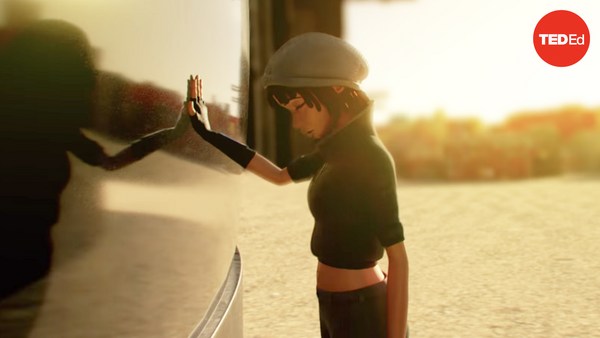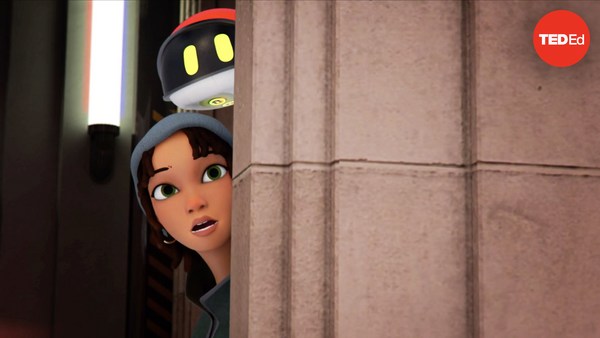Their fall from the tower sends Ethic and Hedge spinning into the rapids of a river of pure energy. This torrent flows from the Bradbarrier all the way to Huxenborg. There an entire city’s worth of factories build the robots and house the Node of Memory, the last of the three powerful artifacts Ethic needs to collect.
After a long day and a longer night they find themselves in a canyon of brick and steel. Just when they’re about to reach the end of the line, a rope catches them.
Their savior, Lemma, has been waiting for them. When Ethic claimed the Node of Creation from the forest tower, radios all across the land came back to life. Adila, the resistance leader, immediately started contacting her allies, none more important than Lemma, a brilliant scientist working from within Huxenborg to bring down the machines. Unfortunately, the radios also tipped off the robots. So they’ve taken defensive measures to protect the final artifact in its home in the very heart of the city.
There’s only one way to get there: the gauntlet of forking paths. It’s a deadly series of luminous conveyors that wind underneath Huxenborg. Starting from the current position, each section runs for a distance, then splits in two. Every branch does the same thing, again and again. There are thousands of branches. Only one path leads to the artifact; all the others to destruction.
Fortunately, the Node of Creation has granted Hedge a strange power: he can produce slightly smaller versions of himself. Each version can do only two things: radio information back to its parent, and produce slightly smaller versions of itself… which can do the same two things, as can their children, for as many generations as needed. A patrol is closing in on their position, so Ethic’s time is limited. What instructions should she give Hedge to find the one safe path?
Pause the video to figure it out yourself.
Hint in 3
Hint in 2
Hint in 1
Programmers have an elegant tool in their arsenal called recursion. Recursion is when you have a set of instructions that refers back to itself. It’s like using a word in its own definition, except where that’s frowned upon, this is incredibly effective.
Recursion involves repetition, but in a different way than loops. Where a loop takes one action and repeats it again and again, recursion will start an action, and before it’s finished, use it again, and before that’s finished, use it again, and so on. It keeps doing this until some end state is reached. It then passes the information back up, layer after layer, until it reaches the top and ends the cycle.
Recursion is ideal for problems that involve self-similarity, where each part resembles the larger whole. Like, for example, a deadly defense system designed to end any person or thing who dares tread upon it.
Pause the video to figure it out yourself.
Solution in 3
Solution in 2
Solution in 1
Ethic’s conundrum seems sprawling on the surface, but there’s a remarkably simple solution to it using recursion.
In order to find it, let’s first look at the simplest version of this puzzle: what if the entire maze were just two paths? If Hedge copies himself, the copy that goes the wrong way will be destroyed. So the other one, which will reach the artifact, can radio back the path it took, and then no matter which way is correct, that’s the answer Hedge will receive. This is called the "base case" of the recursion.
Now, suppose the maze branches twice from the starting point, and at every intersection, Hedge’s copies— let’s call them Twig 1 and Twig 2— make more copies— let’s call them Leaves 1 through 4. Three Leaves will be destroyed. The one that reaches the artifact will radio back the right answer, but only to its parent. So if Twig 1 or 2 is waiting at an intersection and hears something over the radio, that’s the right way to go to the artifact from where it is. To tell Hedge the right answer from his perspective, the Twig should say which way it went, and then the route it just heard over the radio.
This same process will work no matter how many times the maze branches. Any answer a copy hears on the radio must be the way to the control room from its location, and if it then adds the branch it took, it can tell its parent how to get there as well.
We can sum up the instructions in an action called Pathfinder that every version of Hedge will follow:
1. If you’ve reached the artifact, radio to your parent whether you got there by going left or right.
2. When you reach an intersection, move off the conveyor and send new copies down the left and right paths. Have them each run Pathfinder. This is where recursion comes in, and this may happen many times before the last instruction triggers, which is:
3. If you hear anything over the radio, you should radio to your parent whether you got to your spot by going left or right, then repeat everything you just heard.
Pathfinder is an example of what programmers call functions, subroutines, or procedures. No matter the terminology, the idea is the same— it’s a set of instructions given a label so that it can be easily reused— perhaps even by itself.
And in our case that’ll work perfectly— an entire network of paths mapped using just three instructions.
So here's what happens.
By the time the patrol rounds the corner, Ethic and Lemma have improvised disguises. They try to confuse the bots long enough to buy Hedge time. Finally, Hedge’s radio crackles to life with a series of directions. The three dive onto the conveyor and flee for their lives, with a squadron of enforcer bots in hot pursuit.


